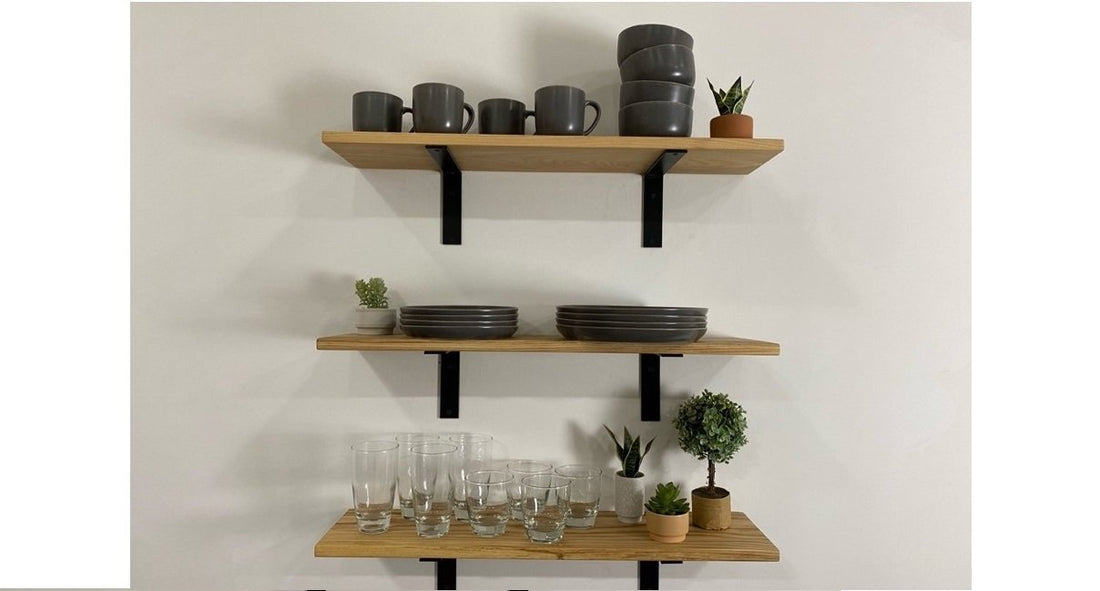
How Much Weight Can a Floating Shelf Hold?
Share
Floating shelves are becoming staples in homes today. It feels like you can't watch any home renovation show on TV without seeing floating shelves incorporated somehow. They're simple and sophisticated additions to any type of home décor. But when you see a floating shelf, you might be wondering, "how much weight can a floating shelf hold?"
So, how much weight can a floating shelf hold? Typically, a floating shelf can hold a lot of weight, approximately 35 to 80 pounds. But this is dependent on the shelf material used, how many wall studs were used to hang the shelf from the drywall, and how wide the shelf is (i.e., the depth). Some floating shelves can hold up to 300 pounds when built properly.
Below we talk about factors that impact how much weight your floating shelves can hold.
What Is the Shelf Holding?
This can seem like an obvious question to ask when you're considering how much weight a floating shelf can support, but it requires some deep thinking.
What will your floating shelves be holding? Will the objects have an impact on the dimensions of the floating shelf? How much do those objects weigh?
These are the types of questions that need to be answered to help you decide what kind of material your floating shelf should be made from, how many studs and rods will be required to hang the shelves from the drywall, and how deep and big the shelf needs to be.
What Kind of Wood Is the Shelf Made From?
What kind of wood your shelving unit is made from will also play a part in determining how much weight can a floating shelf hold.
With several types of wood being used to create floating shelves, knowing how much weight each one can support is important. Here’s a list of several types of wood that you can consider for your shelving unit:
Pine is the most popular type of wood used in North America. It's a more affordable, softer wood that's easy to find in a variety of sizes. It's also easy to stain or paint, which will probably need to be done to achieve the look that you're going for.
One thing to note about pine is that it won't support extremely heavy objects since it's softwood. So, pine is a great, affordable option if you're looking to support objects that aren't too heavy.
Walnut is a hardwood and is considered to be a statement piece of wood. The best thing about choosing walnut is that it won't need to be stained or painted. The downfall of this wood is that it's harder to find and can be more expensive. However, if you need your floating shelves to hold heavy objects, this is the wood type that you want to go with.
Cherry is hardwood as well, but it's more lightweight than other hardwoods. This is an excellent option if you're looking for a reddish, warm, rich-colored wood to support heavy objects.
How Many Wall Studs Are Used?
All floating shelves need to be attached to wall studs – unless they're holding extremely lightweight (under 10 pounds) objects. A shelf holding over 10 pounds needs to be secured to a wall stud with the right mounting hardware because the last thing you want is your floating shelf to fall and break or hurt someone.
The more wall studs that are used, the more weight the shelf can hold. Before hanging your floating shelves, make sure that you have the shelf and shelf bracket attached to the right number of wall studs to hold the load capacity you need it to hold.
How Deep Is the Floating Shelf?

Another thing that needs to be addressed is how deep your floating shelves are. The dimensions of your floating shelves will have a direct impact on how much weight they can hold.
The deeper the shelf, the less weight the shelf can support. If you have no choice but to build a deep floating shelf, you may need to look into heavy duty mounting hardware!
How Many Rods Are Needed?
Every floating shelf needs a minimum of two rods located at the back of the shelf. One of those rods needs to be attached to a wall stud. The number of rods used and how many are attached to wall studs will have a linear relationship to the amount of weight your shelves can hold.
The more rods you have, and the more studs you use, the more weight the floating shelves can hold!
Conclusion
After reading this article, we hope you've learned more about how much weight a floating shelf can hold. To answer the question, you need to ask yourself more questions:
- What is the shelf holding?
- What kind of wood are the shelves made from?
- How many wall studs are you using?
- How deep are your floating shelves going to be?
- How many rods will you use?
Once you have answers to all these questions, you'll find your answer to how much weight your floating shelf can hold.
